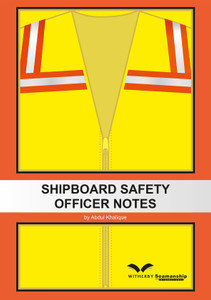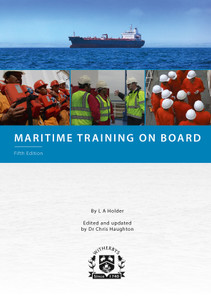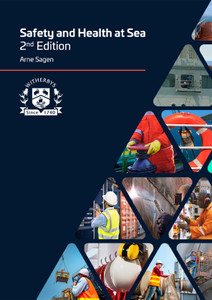
This publication is a comprehensive overview of shipboard safety for crews, trainees and shoreside personnel. It summarises the key elements of safety and provides case studies of relevant incidents. Topics covered include key industry safety legislation, the promotion of safety leadership and general housekeeping considerations.
This publication highlights current safety issues and best practice techniques across all trades and ship types. Although most safety elements are well established, this book addresses more formalised processes such as delegation within a safety organisation. Labelled diagrams illustrate the chain of command and the part all personnel must play to ensure safe operations on board ship. Human Element topics such as ‘Safety and the Individual’ recommend approaches to ensuring staff welfare on both practical and cultural levels.
Onboard safety is a wide ranging and expansive subject that includes aspects of all operations conducted on board all ship types. From the simplest one person task to the navigation and manoeuvring of the largest ship in the world, safety is central to the modern shipping industry.
Oil tankers, gas carriers, car carriers, bulk carriers, container vessels and specialised offshore support vessels all have particular aspects of their operation that require certain skills, competence and levels of safety awareness from their crews. However, there is a vast number of onboard operations that are common to all ships, irrespective of their design and purpose, and it is those common aspects of safety that this book highlights.
The purpose of the book is, therefore, to introduce the fundamental aspects of ship operations that can provide a safe working environment for all on board, from the regulations and guidance that governs and controls safety, to the basic onboard measures that can be used to mitigate risk. These will include the shipboard safety organisation, inductions and familiarisation for new crew, safe means of access to and on board ship, general housekeeping, risk assessments, permit to work systems and specific hazardous activities such as dry-docking, lifeboat launch and recovery, entry into enclosed spaces and mooring operations.
The majority of these key elements of safety are not new. The shipboard safety organisation has existed for many years and risk assessments have always been a central part of onboard safety, although in a less formal manner. Formalised risk assessments, more detailed permit to work systems and more intensive induction and familiarisation processes are all now incorporated into companies’ safety management systems, and it is to these standards that the modern seafarer must adhere.
By summarising the key elements and by providing, where necessary, case studies of related incidents, it is hoped that this book will act as a comprehensive introduction to onboard safety for crews, trainees and shoreside personnel.
1
Regulations
and
Guidance
1.1
Shipping
Industry
Regulatory
Framework
1.2
International
Maritime
Organization
(IMO)
1.3
IMO
Structure
1.4
Flag
State
Authorities
1.5
Port
State
Control
1.6
Classification
Societies
1.7
Key
Legislation
2
The
Human
Element
2.1
Regulations
and
Guidance
2.2
Ship,
Equipment
and
System
Design
2.3
Safety
Management
2.4
Safety
Leadership
and
Safety
Culture
2.5
Safety
and
the
Individual
3
Safety
Organisation
3.1
Regulations
and
Guidance
3.2
Safety
Organisation
3.3
Shore
Based
Management
3.4
The
Master
3.5
The
Safety
Officer
3.6
Safety
Representatives
3.7
Safety
Committees
and
Safety
Meetings
3.8
Safety
Officer
Area
Inspections
4
Inductions
and
Familiarisations
4.1
Rules
and
Regulations
4.2
Inductions
4.3
Familiarisations
5
Safe
Access
and
Safe
Movement
5.1
Regulations
and
Guidance
5.2
Safe
Access
5.3
Safe
Movement
5.4
Walkways
and
Working
Decks
5.5
Stairways
5.6
Vertical
Ladders
5.7
Emergency
Escapes
5.8
Good
Housekeeping
and
Working
Practices
6
Watertight
Doors
6.1
Regulations
and
Watertight
Integrity
6.2
Categorisation
of
Watertight
Doors
(MCA)
6.3
Modes
of
Operation
6.4
Good
Working
Practices
6.5
Incident
and
Accidents
7
Housekeeping
and
Hygiene
7.1
General
Housekeeping
7.2
Galley
Housekeeping
and
Hygiene
7.3
Galley
Equipment
7.4
Housekeeping
and
Hygiene
Inspections
7.5
Galley
Safe
Working
Practices
7.6
Potable
Water
8
Personal
Protective
Equipment
(PPE)
8.1
Introduction
8.2
Regulations
and
Guidance
8.3
Purpose
of
PPE
8.4
Types
of
PPE
8.5
Selection
of
PPE
9
Risk
Assessments
9.1
Regulations
and
Guidance
9.2
Principles
of
Risk
Assessment
9.3
Risk
Assessment
Methodology
10
Permit
to
Work
Systems
(PTW)
10.1
Regulations
and
Guidance
10.2
Principles
of
the
PTW
System
10.3
PTW
System
11
Entry
into
Enclosed
Spaces
11.1
Regulations
and
Guidance
11.2
Enclosed
Spaces
11.3
Enclosed
Space
Hazards
11.4
Enclosed
Space
Entry
Methodology
12
Safe
Use
of
Work
Equipment
12.1
Regulations
and
Guidance
12.2
Measures
and
Controls
13
Mooring
13.1
Assessing
the
Risk
13.2
Permanent
Mooring
Equipment
13.3
Temporary
Mooring
Equipment
13.4
Snap-Back
Zones
and
Hazard
Identification
13.5
Safe
Mooring
Practices
14
Dry
Dock
Safety
14.1
Legislation
14.2
Docking
for
Class
Surveys
14.3
Damage
Repairs
14.4
Ship
Modifications
14.5
Improved
Efficiency
14.6
Types
of
Dry
Dock
14.7
Dry
Dock
Selection
14.8
Planning
and
Preparations
14.9
Docking
14.10
Access
and
Security
in
Dry
Dock
14.11
Work
and
Associated
Hazards
14.12
Control
of
Work
14.13
Monitoring
of
Work
14.14
Emergency
Response
14.15
Undocking
15
Survival
Craft
Release
and
Retrieval
Systems
(Including
Davit
Launched
Survival
Craft
Release
Hooks)
15.1
Introduction
15.2
Lifeboat
Accidents
15.3
Regulations
15.4
Guidance
15.5
Lifeboat
Launch
and
Recovery
Checklist
16
Accident
Investigations
16.1
Regulations
and
Guidance
16.2
Marine
Accident
Investigation
Branch
(MAIB)
16.3
Onboard
Reporting
of
Accidents
16.4
Onboard
Investigation
of
Accidents
16.5
Accident
Area
and
Preservation
of
Evidence
16.6
Witness
Statements
16.7
Voyage
Data
Recorders
(VDRs)
Witherby
Publishing
Group
Witherbys
titles
are
developed
using
scripts
developed
by
technical
experts
that
are
peer
reviewed
within
work
groups.
Typically,
they
seek
to
improve
understanding
of
the
regulations,
recommendations
and
guidelines
issued
by
Industry.
Witherbys staff have significant expertise in the fields of navigation and hazardous cargoes as well as in the presentation of complex subjects in a graphic and easy to understand manner.
Gary Ritchie
Gary Ritchie, Master Mariner BA (Hons), FNI was Marine Superintendent and Tow Master with Marine Consultancy Trident Offshore. He then became Vessel Superintendent for the Subsea 7 ROV support vessel, Seisranger and the construction vessel, Subsea Viking. His current roles with Subsea 7 are Designated Person Ashore and Company Security Officer.
- Number of Pages:
- 196
- ISBN:
- 9781856097550
- Binding Format:
- Paperback
- Book Height:
- 235 mm
- Book Width:
- 155 mm
- Weight:
- 0.8 kg
- Author:
Gary Ritchie
- Published Date:
- November 2017
- Preview:
- Yes






